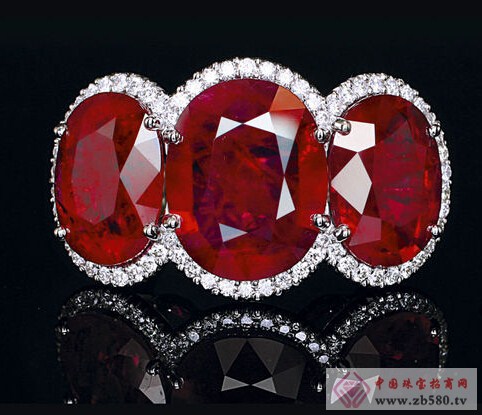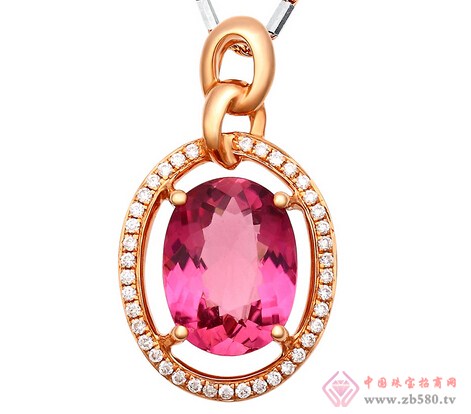How much do you know about rubies and red tourmalines? Here is a brief introduction for everyone.

Ruby Introduction
The English name for Ruby is Ruby, which is derived from Latin and means red. It belongs to the corundum mineral and the trigonal system. It is red to pink because of its chromium content. The higher the content, the brighter the color. Blood red ruby ​​is most cherished by people, commonly known as "pigeon blood red." Rubies and emeralds, golden water bodhi sapphire, tourmaline, etc. belong to the genus of colored gems.
Ruby symbolism
Ruby is named Ruby in English, and ruby ​​is the most precious of all gems in the Bible. The hot red color of ruby ​​makes people always associate it with passion and love. It is known as the "stone of love" and symbolizes the enthusiasm of fire, the beauty, eternality and firmness of love. Ruby is the birthstone of July. Rubies of different colors come from different countries, but they also mean auspiciousness. Red is always the messenger of beauty, and ruby ​​is the best guide to give wishes to others. Among the red of ruby, the most valuable is the jewel with the strongest color, called "pigeon red". This kind of bright, intense color, which can be called deep red, reveals the true face of ruby. Unfortunately, most rubies are reddish in color and have a pink feel, so rubies with pigeon blood tones are even more valuable. Because the ruby ​​is filled with a strong anger and rich colors, the former people thought it was the embodiment of the dead bird, and it had a passionate illusion.
People love rubies and regard it as a symbol of love, enthusiasm and morality, a symbol of glory. Legend has it that people wearing rubies will live long and healthy lives, love and family harmony. The international gem world defines ruby ​​as "July Birthstone", which is a symbol of nobleness, love and love. In Europe, the royal wedding still uses rubies as a witness to marriage. In the international gem market, the bright red ruby ​​is called “male ruby†and the light red is called “female rubyâ€. When a man has a ruby, he can grasp the power of dreams. If a woman has a ruby, he can get the love that will last forever.
Blood red ruby ​​is most cherished by people, commonly known as "pigeon blood red." Its color is bright red and glamorous, and it can be called the "crown crown of red gems". The magnificent and luxurious ruby ​​is the king of gems, the treasure of treasure, and its advantages exceed all gems. Some ancient books consider ruby ​​to be "the most precious of the twelve gems created by God when he created everything."

Main source of ruby
Myanmar
Burmese rubies have two main producing areas, one is the Mugu Valley in Myanmar; the other is Myanmar Meng Su.
Thailand
Thailand is also an important producer and trading center for rubies, and it is reported that nearly 70% of the world's high quality rubies are produced in Thailand.
Sri Lanka
Sri Lankan rubies are known for their high transparency and soft color. Moreover, the particles are larger, and their color changes greatly, from light red to red, pink, brownish red or maroon to cherry red. The high-end products are bright red with a slight pink and yellow tone, often called cherry red or water red. In addition, the ribbon is developed, and the rutile needle is fine, long and evenly distributed.
Tanzania
The common colors of Tanzanian rubies are purple-red and orange-red, while pink and red are less, which is related to the higher Fe, Ti and relatively low Cr of rubies. Most of the ruby ​​cracks have not healed, filled with foreign particles and reduced the transparency of the ruby.
Vietnam
In the 1980s, Vietnam discovered several new ruby ​​producing areas, such as the ruby ​​deposit near Lu'an City in northern Vietnam, the ruby ​​deposit in Caizhou Village in Caizhong, Central Jingjing, and the ruby ​​deposit in the southern basalt area.
China
Chinese rubies are mainly found in Yunnan, Chongqing, Anhui, Qinghai and other places, of which Yunnan ruby ​​is slightly better. Yunnan ruby ​​is produced in the phlogopite marble of the Ailaoshan metamorphic rock distribution area in western Yunnan, but the mining value is secondary sand ore. The ruby ​​grain is 1-10mm, the color is rose red and red. And even. However, the development of cracking, the inclusion of impurities and impurities, the vast majority can only be used as a curved surface gemstone, the original stone with faceted gem quality is rare. The ruby ​​color of Jiangjin Shijingshan is bright, transparent blue, light blue, gray blue, light green, rose red, etc. It contains no or less inclusions and has a high density. It can be applied without color change.

Introduction to Red Tourmaline
Red tourmaline is a tourmaline with red, red, purple, red, purple, and red. In mineralogy it mainly belongs to lithium tourmaline and magnesium tourmaline. The cause of red may be related to trace amounts of manganese and lithium and strontium.
China often refers to the color depth as "double peach red" and the light color as "single peach red". The use of electron radiation allows the colorless and pink tourmaline to achieve a better red color, but sometimes it can cause the gem to rupture. Red is the highest value among the tourmalines, among which the best is purple and rose red, and it is called red tourmaline. In China, there is the name of “baby faceâ€. However, the natural world mainly produces more brown, maroon, and deep red, and the color tone changes greatly.

Red tour method
1. The tourmaline is high in brittleness. If it encounters bumps, it may cause cracks in the tourmaline. When wearing the tourmaline bracelet and ring, be especially careful. Others such as tourmaline stud earrings and tourmaline pendants are not directly involved in the touch, so they are not used. Worried about bumps. Avoid contact with high temperatures and hot water (will fade), do not wear when taking a bath.
2. Do not place tourmaline jewelry and other jewelry in the same drawer to avoid friction and wear. Similar to the first step, because the Mohs hardness of the tourmaline gemstone is slightly higher than other gemstones, it will be scratched and worn, such as crystal or jade, jade, etc., which are lower in hardness than tourmaline; such as diamond jewelry, ruby ​​sapphire The jewelry belongs to corundum, which is higher in hardness than the tourmaline, but will wear the tourmaline, so it is best to store it separately when storing the tourmaline jewelry, or store it separately with other accessories.
3, sideless inlay and micro-inlaid tourmaline jewelry, wear as much as possible to avoid collision, because the borderless inlay and micro-inlaying process is to better highlight the beauty of the tourmaline gemstone, the drawback is that the degree of firmness is not high, easy to fall off, so if found Looseness should be repaired in time to avoid the regret of the precious tourmaline gem falling.
4. If you wear tourmaline for a long time, it will stain the oil and sweat secreted by the human body, thus losing the light. Therefore, it is best to clean it once a month. The cleaning method is very simple. Just soak it in water for several hours, then use soft water. Wipe the cloth. Never clean it in an ultrasonic shaker during cleaning, which can cause cracking.
The above is the introduction of ruby ​​and red tourmaline. Through the introduction of this article, what knowledge did you learn from it?
Our Velour Slippers are ideal for the spa and leisure industry due to their lightweight comfort. Available in Open and Closed toe. 100% Cotton.We offer them in perfects fittings and are extreme comfort. These Slippers are manufactured using premium quality fabric, thread and other embellishments. These Products are available at affordable price range. Our entire product range is well-tested on quality parameters before the final delivery.
Velour Slippers,Velvet Slippers,Cotton Velour Slipper,Hotel Cotton Slipper
Yangzhou Lansun Slipper Co.,Ltd , https://www.lansunslippers.com